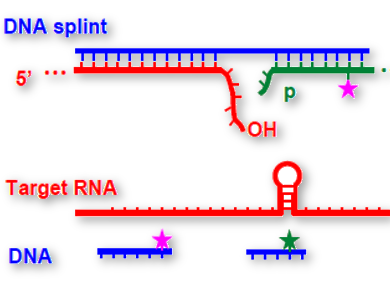Tools to characterize RNAs are essential for basic research, biomedical and clinical applications. Understanding the potential and limits of the different RNA synthesis and labeling strategies is important in deciding how to approach the preparation of a particular RNA molecule. Yu Liu, Rui Sousa, and Yun-Xing Wang, National Institutes of Health, Frederick, MD, USA, and University of Texas Health Science Center, San Antonio, TX, USA, summarize various RNA labeling methods and discuss future directions of the field.
Chemical and enzymatic and combined labeling methodes allow to incorporate labels anywhere within a RNA structure to manipulate its properties. Splint ligation, for example, can either chemically or enzymatically ligate specific RNA molecules together. Position-selective labelling of RNA (PLOR) is a rather new technology. It combines aspects of solid-phase chemical synthesis with liquid-phase enzymatic synthesis, but uses DNA templates coupled to a solid support allowing preparation of long RNAs in which specific segments or sites are specificially labeled.
Most practical approaches to produce milligram scale quantities of labeled RNA with the least structural perturbation are realized with chemical synthesis and the enzymatic-based PLOR method. The chemical synthesis approach has the greatest flexibility for position specific labeling and it is the most efficient for generating relatively short RNAs. Enzymatic methods such as PLOR have greater potential and capability for making much longer transcripts because of the high processivity of the RNA polymerase. What’s more, PLOR is novel in that it couples the automated platform. This has made structural studies of RNAs easier and will in the future allow studying the role of RNA in various biological processes.
Using specifically engineered enzymes and the PLOR method allows the synthesis of RNAs with mosaic nucleotide chemistry. These RNAs may have enhanced RNAse resistance and functionality, could be used for the development of RNA-based therapeutics, and may serve as sensors for biomedical and clinical applications.
- Specific Labeling: An Effective Tool to Explore the RNA World,
Yu Liu, Rui Sousa, Yun-Xing Wang,
BioEssays 2015.
DOI: 10.1002/bies.201500119




